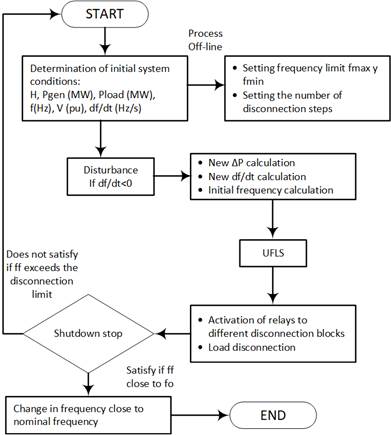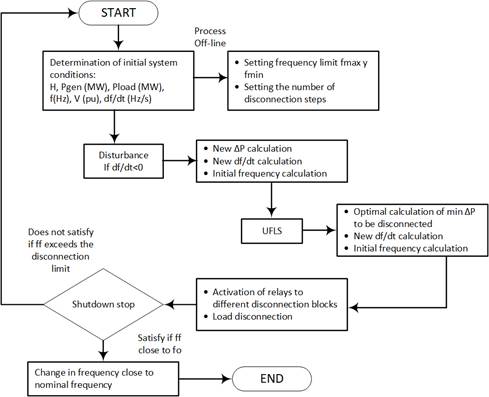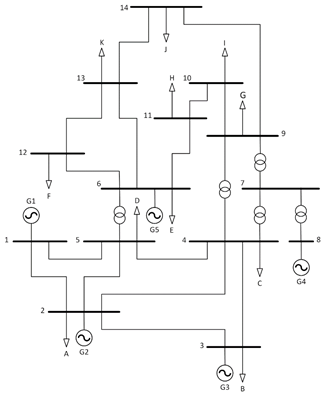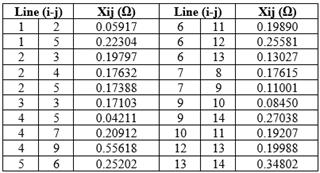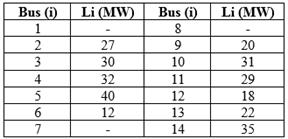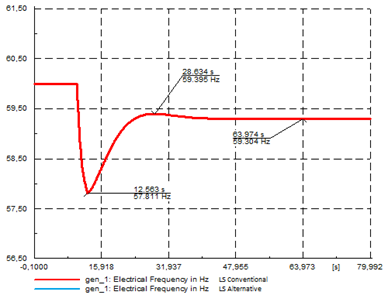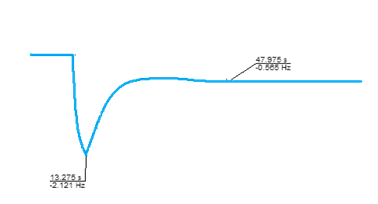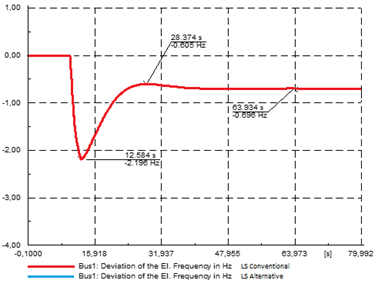1. Introduction
The different elements that make up the electrical power systems (EPS), such as power plants, electrical substations, transmission lines, compensation systems and distribution systems are made of with many control elements and automated processes that act directly on the preservation of the steady state operation of the power system; despite this, events that are difficult to predict and that happen outside the power system that may affect the stability and normal operation of the system may occur (Kundur, 1994; Massucco & Delfino, 2001).
The analysis of which elements affect directly the loss of stability, both in frequency and voltage, implies that in the generation, transmission and distribution stages alternative processes are generated to restore the normal operating ranges of the power system; however, there is a risk that the system will exceed the stability limits and the generation will be insufficient to compensate for the different electrical parameters, causing a general blackout of the system. One of the solutions proposed is the increase of generation plants based on non-conventional renewable energies; but with this option, uncertainty conditions have been introduced to the power grid due to the random nature of the methodological variables (Arias, Vargas & Rahmann., 2015; Carrión, González, Isaac & López, 2017; Guerrón, García & Montero, 2014; Mazaher & Hazlie, 2014; Schmitz & Smith, 2009; Short, Infield & Freris, 2007).
Different methodologies have been proposed in the scientific literature to save power systems from possible blackouts. The most important of which includes the correct planning of EPS expansion, optimal location of compensators and, as a last resort, load disconnection schemes (Kundur, 1994; Kupzog, 2008; Massucco & Delfino, 2001). The disconnection of cargo not only affects the operation of the SEP but also generates annoyance in the end users and in many of the occasions it affects industrial loads or medical services. Thus, when there is a large number of residential users fed by the substation primary as the last strategy to improve or compensate for stability problems, the load disconnection is carried out (Águila, Carrión & Ortiz, 2015; Carrión, González, Isaac, López, & Cardona, 2017; Shokooh et al., 2005).
Traditional EPS have become a smart grid, which are based on communication, control, monitoring and energy management systems to optimize the use of resources and the response to contingencies. The operation control algorithms of the SEP are found in the control centers, where the behavior of all the electrical variables of the EPS is monitored and decisions are made to connect or disconnect elements for events such as low system frequency (Carrión & Gonzalez, 2018; Carrión & González, 2019; Correa, Inga, Inga, & Hincapie, 2018; Inga Ortega, Inga, Correa, & Hincapié, 2018; Maldonado, 2017; Ruiz, Masache, & Domínguez, 2018; Ruiz Maldonado & Inga, 2019).
On the other hand, when you have isolated systems you have many elements whose behavior is random and stochastic, which can be harmful to the network. There is also the disadvantage of the lack of rolling stock due to its limited capacity to expand the system, which is, somehow, to be solved with renewable generation. With the limitation of the generation, there is a poor response to demand demands, which influences load disconnection events (Carrión & Ortiz, 2013; Shafiullah, Alsharif, Hossain & Ahsan, 2014).
Many authors have dedicated themselves to studying blackouts and methodologies of low frequency load disconnection (UFLS); for example in Carrión, Ayo & González, 2019; Laghari et al., 2012; Liu & Thomas, 2011; Perumal & Ying, 2004; Ten & Crossley, 2008; and Tofis, Hadjidemetriou & Kyriakides, 2013, phenomena related to instability in large islands, effects of generation output, impact of renewable generation and different types of contingencies are studied; that is why in that EPS type the presence of the slightest disturbance significantly affects the behavior of the network in voltage, current and power; affecting the reliability and stability of the system.
For the different current protection elements the rule is used for every 1 % frequency decline 2 % of the total load is necessary to disconnect (Anderson, Fouad & Happ, 1979; Massucco & Delfino, 2001; Systems, Committee, Power & Society, 2007).
This research focuses on the development of a new methodology for low frequency load disconnection based on the Semi-Adaptive model, in which changes in the comparative parameters of optimum power to be disconnected are proposed, with restrictions on the deviation of Dynamic frequency of the EPS; as a test system IEEE 14 bus scheme is used.
Onwards, the article is organized as follows: Section II describes the different load disconnection techniques and their influence on the frequency, as well as the times of action they present; in section III, the problem formulation is described; in section IV the state of an electrical system before and after implementing the proposed scheme, as well as its effects on the network, is presented. Finally, the conclusions of the work are offered in section V.
2. Load disconnection scheme
In electrical systems, the power in generation terminals can be directly controlled by the primary and secondary regulation of voltage and frequency, demand response models, system frequency response systems and the rolling stock. In case of the existence of any contingency, the EPS controllers analyze the frequency limits so that the generators change their operating conditions and, in case of not being sufficient, to carry out other alternatives such as the disconnection of load from the system.
The first step to load disconnection processes is to analyze Rate of Change of Frequency (ROCOF), based on the information of the frequency provided by the monitoring system, especially with the critical frequency values that are below the operating limit that cause the system to shut down. The disconnection of the system by low frequency (f) is carried out in a sectorized way, disconnecting loads consecutively until the EPS frequency is within the operating limits. this results in the proportionality of the disconnection that relates the frequency change (∆f) and the amount of disconnected load (∆LS). All the aforementioned processes can also be done through simulations to generate a route map of the disconnection scheme.
A second process is to apply the semi-adaptive method that quantifies the change of frequency in small intervals of time (df/dt), with which the frequency is measured constantly and depending on the amount of disconnected load the speed is determined which ones exceed the frequency limits.
The third method used is the adaptive disconnection model, which considers the change in power (∆P) caused by the drop-in frequency that directly affects the inertia of the generating machines. This effect has a response in time as indicated in (1), which is related to the disconnection scheme shown in (2), which quantifies the portion selected for relief. The adaptive method is adjusted to the contingency present in the EPS, estimated from the least representative value that helps to obtain the LS.
(1)
(2)
The frequency protection relays are based on ROCOF for their action against events in the EPS and the basis of the algorithm is the analysis of the zero crossing and the Fourier transform. In reference to the response time and to avoid false activations, the response time of the relay is between 50 and 500 ms, which increases the reliability of the device.
The measurement window is determined by the number of frequency periods over which the frequency change will be calculated; usually up to 100 cycles are considered. Possible interlocks due to low voltage should be considered, which may block the action of the frequency relay. Such consideration is beneficial when starting up generators or short circuits in the EPS.
The structure of a frequency relay with ROCOF is shown in Figure 1 (Ten & Crossley, 2008). There are a lot of procedures and criteria that should be considered to design the load disconnection process that includes:
• Maximum overload advance
• Number of load disconnection steps
• Load disconnection size at each step
• Frequency adjustment
• Time delays
• Location of frequency relays
3. Problem formulation
Frequency relays that use ROCOF as the activation method start the process assuming a generation-load imbalance. Immediately after the separation of islands occurs, a power imbalance is generated, which can cause a dynamic change of frequency, and, by neglecting the action of the machine controller, the equation (3) can be approximated (Massucco & Delfino, 2001; Ten & Crossley, 2008).
(3)
Where the variables P_G and P_L correspond to the power of the generator and the power of the load that will vary depending on the instability, as H corresponds to the constant of inertia. Likewise, in the calculation of the static ROCOF algorithm, the inertia parameters are calculated using (4) initial time (5), disconnection time (6), disconnection frequency (7), overload after disconnection (8), df/dt after disconnection (9) (Zin, Hafiz & Wong, 2004):
(4)
(5)
(6)
(7)
(8)
(9)
The scheme shown in Figure 2 shows the procedure mentioned by performing the LS in disconnection percentages determined at set values of frequency limits. Thus, in Figure 3, the established method allows us to modify the previous process by minimizing the ΔPf, with which the variation of one min (df/dt) is reduced by helping to increase the final frequency of restoration, improving the stability process.
4. Results analysis
To test the proposed methodology, the IEEE 14 bus test model is used, as can be seen in Figure 4, with thermal generation units. Table 1 shows the data of the generation units, Table 2 shows the data of the power system reactance and Table 3 shows the demand information.
Considering that the slack bus is 8, studies are made on the generator connected and the frequency relays with 100 % overload are analyzed, and its response when applying a conventional disconnection scheme can be seen in Table 4. Table 5 shows the EPS response when applying the proposed load disconnection methodology. When applying the alternative methodology for low frequency load disconnection based on the semi-adaptive model, the EPS is more stable and the frequency change is closer to the nominal values of the system.
In contrast, Figure 5 shows the variation in frequency with respect to time with and without the proposed algorithm. Figure 6 shows the deviation in Hz with and without the proposed algorithm, remembering that the proposed algorithm try to find to minimize the df/dt of the system.
When comparing the results obtained in Figure 5, it shows that the low frequency improves after the application of the proposed method, going from a low frequency level of 1.16 % to 0.93 %; where the SEP remains in normal operating conditions within the range of ± 1 %.
5. Conclusions and recommendations
The behavior of an electrical system is not a linear and stable process, which is why uncontrolled variations of parameters such as voltage and frequency at any point in the system can lead to critical stability behavior; activating security protocols and even affecting elements that depend directly on power such as transmission system cables by overloading them.
In this investigation, the response of the system referred to the change of generation given by the load has been tested and how the ROCOF relay action influences to prevent the system from straining its machines, minimizing the df / dt factor, leading to a lower frequency decrease of the system.
The ability of an electrical system to cope with disturbance states depends largely on the generation machines in their rolling reserve capacity, as well as on the control components that are available to reduce the impact of these disturbances on the system.
Although the analysis of energy not supplied has not been the subject of analysis, it must be taken into account in the procedures of electrical dispatch due to this being an economic technical characteristic of the electrical system.














